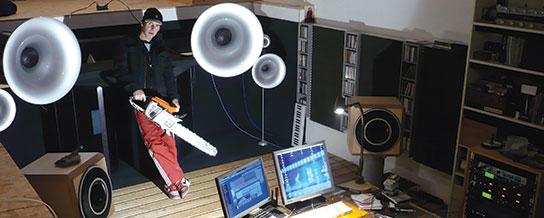Thomas Brinkman in the Studio
Minimal techno icon Thomas Brinkmann is probably more of a gearhead than he lets on. […]

Thomas Brinkman in the Studio
Minimal techno icon Thomas Brinkmann is probably more of a gearhead than he lets on. […]

Minimal techno icon Thomas Brinkmann is probably more of a gearhead than he lets on. A peek into his studio reveals some of the most high-tech stuff we’ve seen, but it’s the last thing he wants to talk about–if pressed on the topic, he’ll more than likely lie his way through it (tongue in cheek, of course) to get to talk about his artistic process.
Over the course of countless albums, 12-inches, and high-art sound experiments, the German native has established himself as the Dalai Lama of thinking-man’s techno. His thoughtful soul and funk deconstructions as Soul Center bring more than just James Brown and African-American spiritual samples to the dancefloor, just as his reinterpretations of Mike Ink’s and Richie Hawtin’s minimalist works (crafted with his home-modified three-tone-arm turntable) could hardly be considered simple remixes. So what does he have in store for trimming the fat from pop music? His latest album, When Horses Die, released on his own Max Ernst label. It’s a paean to Nine Inch Nails, Joy Division, and Suicide, where he exposes pop’s insides, and swaps in his own goth-y vocals and poetic verses from the likes of Robert Smithson. Here, we do our best to get behind the complex structure of Brinkmann’s studio approach.
XLR8R: Where is your studio?
Thomas Brinkmann: In the Eifel region of Germany [near Cologne]… Nobody knows, really! It’s just a big forest and a nature reserve. More trees, less people, no city, no village–and no Beefheart.
What is your basic studio set-up?
I use Martion speakers–the one and only. Nobody knows them in the States except that Canadian, Mr. Hawtin. Some computers–both PC and Mac. A Rickenbacker bass, Fender Stratocaster, Gibson Les Paul Custom, Gretsch drums, stupid name-dropping [laughs]… all the gear I could never play… I don’t care much about studio set-ups. They don’t fit in a notebook [computer]. I do not have one of these guitars or drums in reality, but in my mind. Pro Tools, ahhh! Eventide, oooh! Gibson, wow! I listen to music done with nothing and it’s more touching. That matters. All this gear is a crutch to get there.
What influenced When Horses Die?
I mention some on the cover–Trent Reznor (“Right Where It Belongs” and others) and Winston Tong–but [you won’t] find something of theirs on the album (except Tong’s lyrics)… I just listened to them, Stina Nordenstam, Joy Division, Viktor Zoi, Zemfira, and some others.
Where did the desire to use your own vocals come from?
From poetry… and ’cause I cannot sing. You can find vocals in my other productions, but not the way I use them on Horses. It’s another step.
Did the tracks come about relatively quickly, compared to your techno tracks?
They did come quickly, but it took me a lifetime, really… You have to end up here with the whole story [already written]… I don’t wanna talk about techno, though. It’s boring to talk about it. Better to play it.
Do you try to separate musical art-making from making dance music, or do you see them as the same thing?
Art is art and everything else is everything else, like Ad Reinhardt said. But I also agree with Joseph Beuys or John Cage by saying the contrary, [that everything can be art]. Merce Cunningham, Cage, and dance music… fortunately, there is more to it than just Detroit or Cologne, techno, house, hip-hop, or whatever.
So they’re equally important?
It’s like asking, do you see Norman Foster and carton architecture [homeless people using plastic and packaging], let’s say, in Tokyo, as equally important. For who? For the people inside? For visitors? For representation? I just care about my needs, and if there is a hypothetic alter ego somewhere who can share this or use it in a way, that’s a good thing.
In the past you’ve carved into records and used custom-made turntables to create new sound sources. Were there any similar techniques used on When Horses Die?
While I was producing this album, lots of electronics around me died… The generator in my car, my mobile phone, a Vestax filter, two transformers, one hard disk, a monitor, a buzz saw.
How about software? Is it still working?
Finally the Native Instruments hotline helped me to install the Akoustik Piano. It was driving me crazy. Also the guy from HGF was nice. I use their ProtoPlasm, Shuniji, and STS 26 synths.
On “Meadow,” are those all electronic instruments or some real ones too, like live bass?
That’s a funny question, about virtuality: If your senses don’t get it, there is no reason to ask me whether it’s “real” or not. It seems you took it to be real and you should maybe doubt your senses. There are “real” instruments but I don’t know what real means anymore.

